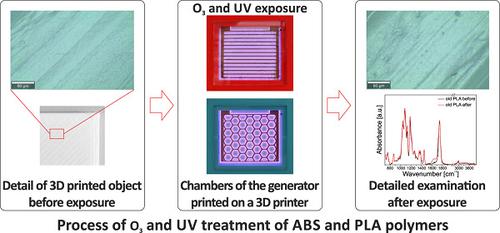当前位置:
X-MOL 学术
›
Plasma Processes Polym.
›
论文详情
Our official English website, www.x-mol.net, welcomes your
feedback! (Note: you will need to create a separate account there.)
3D printing materials for generators of active particles based on electrical discharges
Plasma Processes and Polymers ( IF 2.9 ) Pub Date : 2019-12-02 , DOI: 10.1002/ppap.201900150 Jan Mikeš 1 , Stanislav Pekárek 1 , Oleg Babčenko 1 , Ondřej Hanuš 1 , Jakub Kákona 1 , Pavla Štenclová 2
Plasma Processes and Polymers ( IF 2.9 ) Pub Date : 2019-12-02 , DOI: 10.1002/ppap.201900150 Jan Mikeš 1 , Stanislav Pekárek 1 , Oleg Babčenko 1 , Ondřej Hanuš 1 , Jakub Kákona 1 , Pavla Štenclová 2
Affiliation

|
In this study, we focus our attention on the impact of ozone (O3) and ultraviolet radiation (UV) on materials usable for three‐dimensional (3D) printing. Specifically, we have studied the potential degradative effect on the most commonly used filaments, such as polylactic acid (PLA) and acrylonitrile–butadiene–styrene (ABS). The effect has been examined on objects printed on a 3D printer and on the materials of discharge chambers of O3 generators from which they were printed. For the purpose of adequate assessment of the actual impact of O3 and UV, samples were monitored for a period of 18‐hr of exposure. The methods of Raman spectroscopy, optical and scanning electron microscopy and Fourier‐transform infrared spectroscopy (FTIR) have been employed for an objective evaluation of potential modifications. A generator equipped with a chamber printed from a new PLA filament and an active electrode system in the form of a stripes electrode, or more precisely, in the second case, a honeycomb‐active electrode, both cut out of a thin copper foil, was used for the generation of O3 and UV radiation. The tested materials showed substantial resistance to O3 exposure under the test conditions. The result of measurements suggested that these materials could be used for chambers for the O3 as well as for active particle generation.
中文翻译:

用于基于放电的活性颗粒发生器的3D打印材料
在这项研究中,我们将注意力集中在臭氧(O 3)和紫外线(UV)对可用于三维(3D)打印的材料的影响上。具体来说,我们已经研究了对最常用的长丝,例如聚乳酸(PLA)和丙烯腈-丁二烯-苯乙烯(ABS)的潜在降解作用。已经对在3D打印机上打印的对象以及从中打印对象的O 3发生器放电室的材料上的效果进行了检查。为了充分评估O 3的实际影响和紫外线,对样品进行18小时的暴露监测。拉曼光谱,光学和扫描电子显微镜以及傅立叶变换红外光谱(FTIR)的方法已被用于客观评估潜在的修饰。发电机配备有由新的PLA灯丝印制的腔室和带状电极形式的有源电极系统,或者更确切地说,在第二种情况下,是均由薄铜箔切出的蜂窝状有源电极。用于产生O 3和紫外线辐射。被测材料在测试条件下显示出对O 3暴露的实质抵抗力。测量结果表明,这些材料可用于O 3的腔室。 以及用于产生活性粒子。
更新日期:2019-12-02
中文翻译:

用于基于放电的活性颗粒发生器的3D打印材料
在这项研究中,我们将注意力集中在臭氧(O 3)和紫外线(UV)对可用于三维(3D)打印的材料的影响上。具体来说,我们已经研究了对最常用的长丝,例如聚乳酸(PLA)和丙烯腈-丁二烯-苯乙烯(ABS)的潜在降解作用。已经对在3D打印机上打印的对象以及从中打印对象的O 3发生器放电室的材料上的效果进行了检查。为了充分评估O 3的实际影响和紫外线,对样品进行18小时的暴露监测。拉曼光谱,光学和扫描电子显微镜以及傅立叶变换红外光谱(FTIR)的方法已被用于客观评估潜在的修饰。发电机配备有由新的PLA灯丝印制的腔室和带状电极形式的有源电极系统,或者更确切地说,在第二种情况下,是均由薄铜箔切出的蜂窝状有源电极。用于产生O 3和紫外线辐射。被测材料在测试条件下显示出对O 3暴露的实质抵抗力。测量结果表明,这些材料可用于O 3的腔室。 以及用于产生活性粒子。











































 京公网安备 11010802027423号
京公网安备 11010802027423号